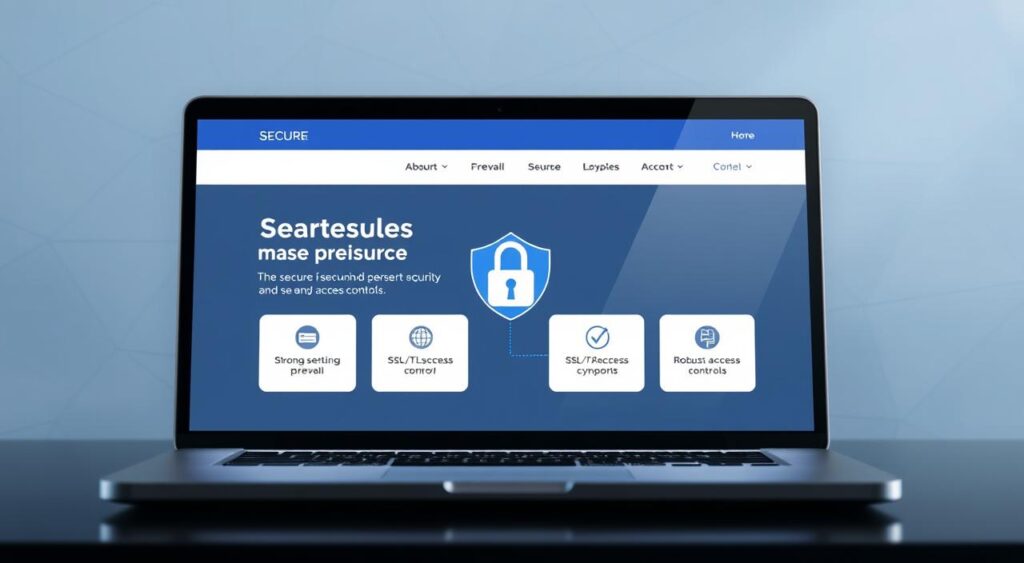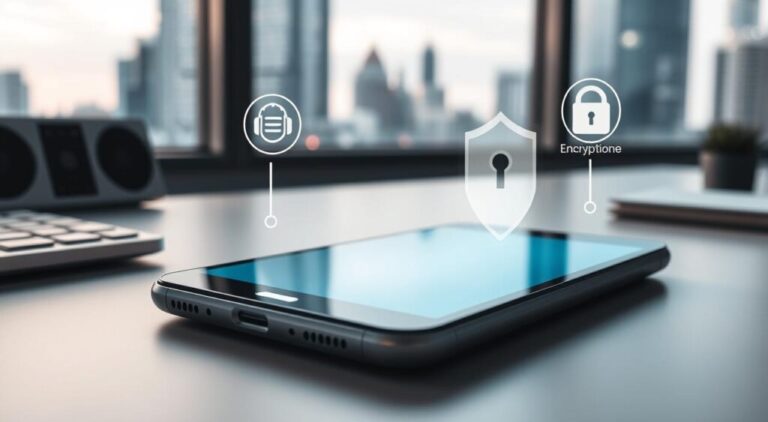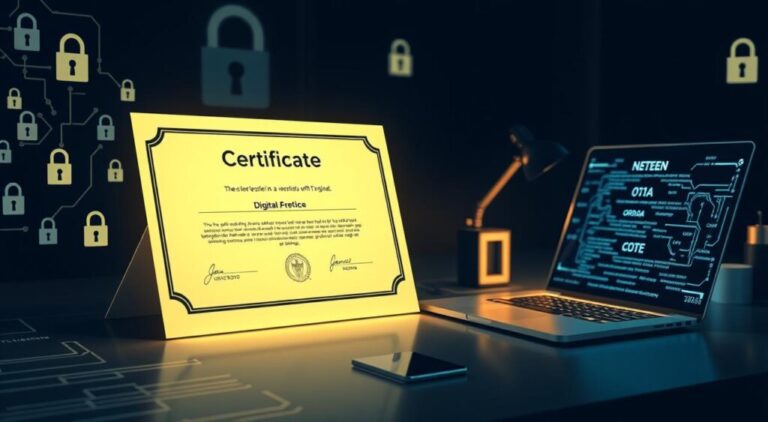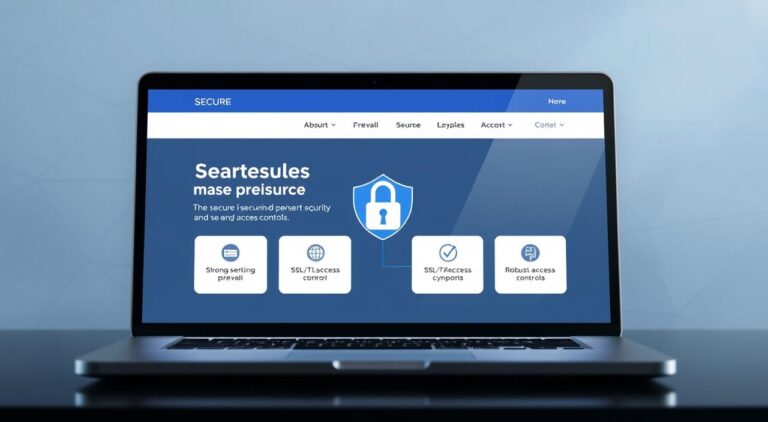
Your online presence is like your business’s face. It’s vital to keep it safe from cyber threats. In today’s world, strong website security is key. It protects your data and keeps your audience trusting you.
When you’re online, think about how to keep your business safe. Website security stops cyberattacks and data breaches. It saves your money and reputation, helping your business grow and stay secure.
Understanding Website Security Fundamentals
When you’re online, you face many website security threats that could harm your personal info. It’s key to know the basics of keeping your site safe. This means knowing about dangers like malware and phishing, and how to stop them.
Your website is a big deal that needs constant care and security. If it gets hacked, you could lose money, hurt your reputation, and lose customer trust. Keeping your site safe is all about protecting your data.
Some important parts of website security basics are:
- Keeping software and plugins up to date to avoid weaknesses
- Using strong passwords and two-factor authentication
- Setting up a web application firewall (WAF) to block attacks

By focusing on these key security points, you can lower the chance of cybersecurity attacks. Remember, keeping your site safe is a never-ending job. It needs constant watching and upkeep to keep your site and data safe.
Essential Website Security Measures You Can’t Ignore
When you start your online journey, protecting your digital world is key. Cyber threats are getting smarter, and ignoring security can put your site at risk. To keep your website safe, you need to use strong security steps.
Important steps include using strong passwords, enabling two-factor authentication, and keeping your site’s software and plugins updated. Regular security checks can also spot and fix threats. These actions help lower the chance of cyber attacks and keep your online space safe.
Also, think about using a web application firewall (WAF) to block bad traffic. This can stop attacks like SQL injection and cross-site scripting (XSS). By focusing on website security and investing in cybersecurity, you protect your online space and keep your users’ trust.
Here are some top tips to remember:
- Regularly update your website’s software and plugins
- Use strong, unique passwords for all user accounts
- Enable two-factor authentication for extra security
- Do regular security audits to find and fix issues
By following these key security steps, you can safeguard your online presence and protect your users’ data. Remember, keeping your site secure is an ongoing task that needs constant attention to stay safe from new threats.
Securing Your Website Authentication Process
Building and keeping your online presence safe is key. You need to focus on making your website’s login process secure. This means setting up strong password policies to keep out unwanted visitors and protect your data. This way, you can lower the chance of hackers getting in and stealing your information.
Using two-factor authentication is also a smart move. It makes users give a second proof of who they are, like a code sent to their phone or a fingerprint scan. Adding this extra step makes it harder for hackers to get in.
Best Practices for Website Authentication
- Implement strong password policies that require unique and complex passwords
- Use two-factor authentication to add an extra layer of security
- Regularly update and patch your website’s authentication system to prevent vulnerabilities
By sticking to these best practices, you can keep your online space safe. Always watch over your website’s login process to keep your data safe from hackers.
Data Encryption and SSL Certificates
When you’re looking to make your website safer, think about data encryption and SSL certificates. Data encryption is key to keeping sensitive info, like credit card numbers, safe from hackers. It makes sure your website’s data is secure, whether it’s moving or sitting still.
SSL certificates are vital for a safe link between your site and visitors’ browsers. With an SSL certificate, you know your site is safe and trusted by everyone. SSL keeps data safe as it travels, stopping hackers from getting to it. SSL certificates are a must for keeping your site safe from many dangers.
Using data encryption and SSL certificates has many benefits:
- They protect sensitive info, like credit card numbers and personal data.
- They create a safe connection between your site and visitors’ browsers.
- They boost your site’s security, stopping unauthorized access and many threats.
Adding data encryption and SSL certificates to your site’s security plan makes it much safer. This builds trust with your visitors and helps your site succeed for a long time.
Protecting Against Common Website Security Threats
As you grow your online space, keeping it safe is key. Your site faces threats like malware, DDoS attacks, and SQL injection. To keep it safe, use antivirus software and update your site’s software regularly.
Protecting your site from DDoS attacks is crucial. Use a content delivery network (CDN) and rate limiting. These steps help block DDoS attacks and keep your site open to visitors. Also, stay alert to website security threats and act fast to stop them.
- Set up a web application firewall (WAF) to block common web attacks.
- Install a trusted security plugin to find and fix vulnerabilities.
- Keep your site’s software and plugins updated to avoid known issues.
By focusing on malware prevention and DDoS attack protection, you lower your site’s risk. Remember, keeping your site safe is a constant job that needs regular checks and updates.
Regular Maintenance and Monitoring Best Practices
As a website owner, you know how vital it is to keep your online space safe. Regular maintenance is key to keeping your site secure. This means using tools to scan for threats and fixing any issues found.
Regular website maintenance tasks include updating and patching software and plugins. This helps block security breaches and keeps your site safe. By keeping up with update and patch management, your site stays secure.
Some top practices for regular upkeep and watching include:
- Using security scanning tools to find potential threats
- Updating and patching software and plugins often
- Having backup plans to protect your data
By sticking to these practices, you can keep your website safe from many threats. Remember, regular care and watching are essential for safeguarding your online presence.
| Maintenance Task | Frequency |
|---|---|
| Security scanning | Weekly |
| Software updates | Monthly |
| Backup | Daily |
Taking Your Website Security to the Next Level
To make your website more secure, you need to keep working on it. Start with the basics and then add more to keep your site safe. Using new tech like artificial intelligence can help a lot.
Always be ready to check and update your security. Look out for any strange activity. Keeping your site safe is a constant job, but it’s worth it to protect your online world.
FAQ
What are the common website security threats?
Common threats include malware, phishing, and DDoS attacks. These can harm your website and risk your data.
Why does my website need protection?
Your website is valuable and needs security to avoid cyberattacks. Breaches can cause financial loss, damage reputation, and lose customer trust.
What are the essential website security measures I can’t ignore?
Key measures include strong passwords, two-factor authentication, and updated software. Also, use a web application firewall and do regular security checks.
How can I secure my website’s authentication process?
Secure authentication with strong passwords, two-factor authentication, and manage user access. This ensures users only see what they need.
Why is data encryption and SSL certificates important for website security?
Data encryption and SSL certificates protect sensitive info like credit card numbers. They create a secure connection between your site and users’ browsers.
How can I protect my website against common security threats?
To protect against threats, use malware prevention, DDoS attack protection, and SQL injection defense. Also, prevent cross-site scripting (XSS). These steps can block various attacks and keep your site safe.
What are the best practices for regular website maintenance and monitoring?
Best practices include using security scanning tools and implementing updates. Also, have strong backup strategies. These steps help find and fix security issues and ensure data recovery in case of a breach.
How can I take my website security to the next level?
To enhance security, implement essential measures, secure authentication, and use encryption and SSL certificates. Also, protect against common threats and follow maintenance and monitoring best practices. Stay updated with the latest security trends and use tools like artificial intelligence and machine learning.





